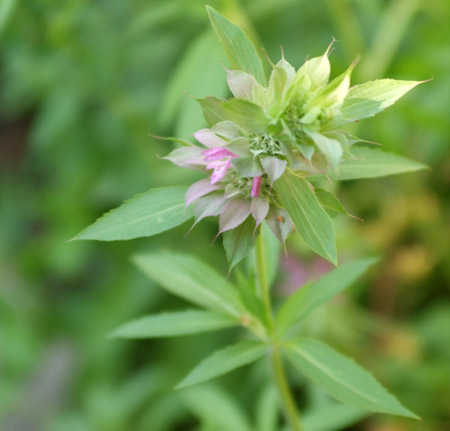
Speaking of mint, check out the unique and gorgeous flowers on the ‘Lemon Mint’ plant. I purchased this particular variety as an impulse buy in early spring when herbs were 3 or 4 for $10 and I couldn’t steer my bike in the general area around known garden shops without popping in for “just a peek” and then finding myself tentatively and rather unsafely riding home with a basket full of something-or-other.
All of that just to say that I really had no idea what I was getting myself into when I bought this plant except that I was working on an expanding collection of mints and I’m constantly on the lookout for a lemony herb that can rival the fresh lemon zip of Lemon Verbena. I can tell you right now that despite the name ‘Lemon Mint’ doesn’t even make it into the parking lot of the stadium that holds the ring where possible contenders would go head-to-head with the mighty Lemon Verbena. It might make it onto the highway that leads to the parking lot of the stadium or maybe the fallow field next to the parking lot of the stadium but that’s only because I’m feeling generous.
But I digress.
So it turns out that the plant commonly referred to as ‘Lemon Mint’ is in fact a type of beebalm, Monarda citriodora to be exact. I noticed that it looked kinda odd (square, tought stems) and rather un-mentha-mint-like when I purchased it but REALLY started to notice a problem when the first flowers bloomed. This is another fine example of why common names are misleading. Monarda citriodora is in fact a member of the mint family but is not what you picture in your mind when you think mint. It is also commonly called: Lemon bee balm, horsemint, lemon bergamot, plains horsemint. This non-mint mint cousin prefers a sunny location but doesn’t mind a little bit of shade which is why it hasn’t keeled over from its current position in the shadiest spot of my community plot tucked in alongside the ‘Ginger’ and ‘Mojito’ mints.
Now that I know the true nature of this plant I plan to move it to a slightly sunnier position in the garden. As far as use goes the plant is most commonly brewed up as a tea or added to salads. The mint name is misleading since it does not have a refreshing minty taste (or much of a lemon taste for that matter) but has a much stronger, muskier, thyme/oregano flavor better suited to savory meals than summery beverages. I picked the flowers shown in the photo above several days ago and they have been thriving in a vase in my kitchen since without showing signs of wilt or petal drop.
I’m growing the same thing, although i knew what i was getting into when i started the seeds. It’s filled out a planter of mine so nicely. i like the low bushiness of it. I’m currently drying some bunches and am going to test it as a tea.
Hi Gayla,
I just have a quick question…I made a nice little mint planter this year (just peppermint, spearmint and ginger mint) and all are doing well except for the peppermint. It has what I think might be powdery mildew. Have you been having any problems with this and your peppermint this year?
Very nice!